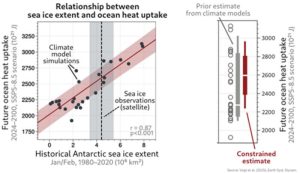A groundbreaking study has provided a critical and previously underestimated connection between Antarctic sea ice, cloud cover, and global warming.
The research indicates that the current extent of Antarctic sea ice is greater than predicted by climate models, suggesting that we can expect more significant global warming in the coming decades.
The study, led by Linus Vogt from Sorbonne University, utilised an emergent constraint based on data from 28 Earth system models and satellite observations from 1980 to 2020.
This constraint enabled the team to reduce uncertainty in climate projections and provide more accurate estimates of key climate variables.
Sea level rise could be up to 14% higher than previously predicted
The results of the research indicate that ocean heat uptake and the resulting thermal sea level rise by the year 2100 are projected to be 3-14% higher than the average from CMIP6, a leading collection of climate models.
Moreover, the projected cloud feedback is 19-31% stronger, which enhances climate sensitivity, and global surface warming is estimated to be 3-7% greater than previously thought.
The role of Antarctic sea ice in nearby climate variations
The study found that the extent of Antarctic summer sea ice, which has been considered stable and only weakly connected to human-caused climate change, is a crucial indicator of the Southern Hemisphere’s climate.
Models that start with a higher, more accurate representation of pre-industrial sea ice levels simulate colder surface waters, colder deep ocean temperatures, and thicker cloud cover in the mid-latitudes.
 Fig. 1 (left): a strong relationship was found between historical Antarctic sea ice extent and future global ocean heat uptake across climate models. (right): combining this relationship with sea ice observations from satellites results in increased estimates of future ocean heat uptake by up to 14%.
Fig. 1 (left): a strong relationship was found between historical Antarctic sea ice extent and future global ocean heat uptake across climate models. (right): combining this relationship with sea ice observations from satellites results in increased estimates of future ocean heat uptake by up to 14%.
These initial conditions then amplify the warming responses under greenhouse gas forcing, meaning they lead to a more severe and accelerated warming effect than previously estimated.
“When we initially discovered this link between historical Antarctic sea ice and future global ocean heat uptake, we were surprised by the strength of the relationship. Antarctic sea ice covers less than 4% of the ocean’s surface, so how could it be so strongly associated with global ocean warming?” said Linus Vogt, who led the study.
“After a lot of analysis, we understand the full implications of the sea ice-ocean-atmosphere coupling, which is responsible for these global changes.”
The role of clouds in accurate climate projections
Higher sea ice extent enhances cloud cover, which has a cooling effect overall by reducing the amount of incoming solar radiation.
Greater sea ice loss in the coming decades is therefore linked to larger reductions of clouds, stronger surface warming, and enhanced ocean heat uptake.
As a result, the baseline state of sea ice and deep ocean temperatures in models effectively preconditions the magnitude of future warming, cloud feedback, and heat uptake.
Jens Terhaar, a senior scientist at the division of Climate and Environmental Physics at the University of Bern, explained: “While it has long been known that accurately representing clouds is crucial for climate projections, our study highlights that it is equally important to also accurately simulate the surface and deep ocean circulation and its interaction with Antarctic sea ice.”
Implications for policy and science
This new study provides evidence that current models may be underestimating future warming and ocean heat storage, as these models tend to simulate a too warm Southern Ocean in the preindustrial state and have too little warming potential.
It also emphasises the importance of ongoing satellite monitoring and enhanced modelling of cloud processes and deep ocean hydrography, both of which significantly influence global climate projections.
Vogt concluded: “Several high-profile studies have used temperature trends over recent decades in an attempt to constrain future warming. However, we now found that this approach can give misleading results.
“Accounting for the sea ice-related mechanism we identified leads to increased estimates of future ocean and atmospheric warming. This likely stronger warming calls for urgent action to reduce greenhouse gas emissions to avoid the increased heat waves, floods and ecosystem impacts associated with ocean warming.”

